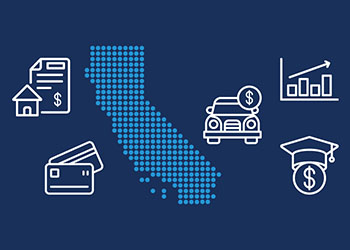-
-
- | By:
-
Latest Update: March 22, 2024
- Updated all dashboards with 2023 Q4 data
- Created new Financial Trends snapshot
Charts
Maps
Insights
California Financial Trends snapshot
Periodically, the California Policy Lab publishes Data Points highlighting trends in the data or diving deep on a specific issue.
- April 2023 – Startling Increase in California Auto Loans (Data Point
 | Press Release)
| Press Release) - Dec 2022 – Introducing the CCD (Data Point
 | Press Release)
| Press Release)
About the California Credit Dashboard
California is the fifth largest economy in the world and has more people than the least populous 22 US states combined. What happens in California affects the world.
Yet to date there has been little information available about household financial balance sheets at the state level. The California Credit Dashboard seeks to fill that gap.
The Dashboard provides measures of financial health for California’s diverse population. What type of debts do they have? How many are delinquent? What is the current pace of originations? How are credit scores faring? Our data come from one of the three nationwide credit bureaus.
We break out data by subgroups so that users can compare different profiles. We currently provide breakdowns by loan types, regions, and age groups. In the future, we hope to provide more breakdowns.
Feedback? Please email creditdashboard@capolicylab.org.
Changelog
3/22/24:
- Added Q4 2023 data
- Launched Financial Trends snapshot
- Changed credit utilization chart to average consumer-level utilization, rather than population-level utilization.
11/20/23:
- Added Q2 2023 data, and new maps allowing users to plot changes in credit scores, total originations, and average loan originiations.
7/27/23:
- Added Q1 2023 data, new chart (monthly payments), and new map features (customizing date ranges and population filters).
4/4/23:
- Added Q4 2022 data, new charts (total originations, foreclosures, repossessions, credit-card utilization), launched first map (delinquencies), new dashboard features (inflation adjustments, filter by credit score buckets).
- Used a 2% subsample, rather than 1%.
- Implemented new method for eliminating tradeline duplicates where two tradelines have different trade keys but all other relevant attributes are the same. This reduced Ns and changed displayed values.
12/21/22:
- Launched Dashboard with five charts: average balances, total outstandings, average originations, 30-day delinquency rates, and average credit scores. Charts had filters by region, generation, and loan type, and a seasonal adjustment option.
(^ Top)

